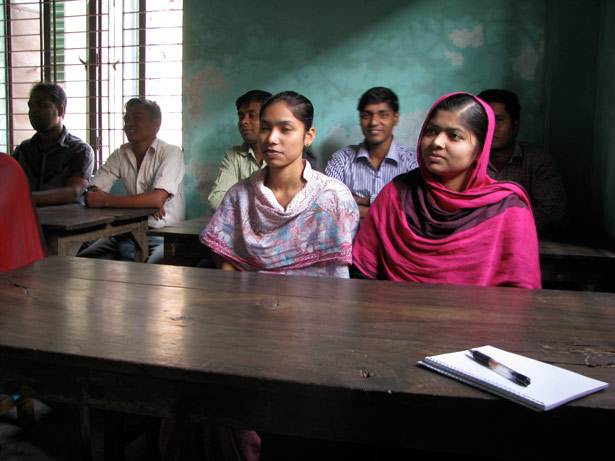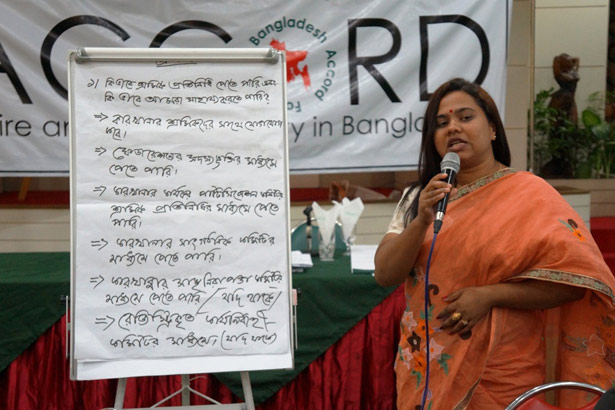One of the major achievements of the labor movement in the aftermath of last April’s Rana Plaza factory tragedy is the Accord on Fire and Building Safety in Bangladesh. The agreement, which was negotiated by worker advocates and brands last year and is now in its first stages of implementation, is ostensibly a landmark set of health and safety regulations for the country’s burgeoning garment industry. But it is also a political document, and a response to a horrific history of industrial accidents in the Global South. Even more, it symbolizes the tension between the politics of enforcement, and the imperative of public health, where workers now have an opening to win more control over their workplaces.
That said, the very fact that the framework is so basic—make sure that they are working in a safe building and don’t have to worry about risking their lives each workday—shows what a hard climb it will be before Bangladesh workers are able to fully assert their rights at work. Moreover, the agreement addresses structural and fire safety issues, but does not directly deal with other common health hazards in factories like chemical exposures, mechanical accidents, and repetitive stress injuries. There are also long-term health issues associated with poverty and sheer physical exhaustion that come with the long hours and backbreaking drudgery of garment production. Other workplace risks overlap with structural social problems, like crowded conditions, the presence of child labor and sexual or physical abuse at the hands of bosses.
And then there is the key question of who will be doing the enforcement. Conventional third-party factory auditing programs used by multinationals like WalMart have historically served as effectively a corporate rubber stamp. Moreover, corruption is endemic in Bangladesh’s garment sector, with close collusion between top industrialists and the political class.
But the Accord does include clear provisions requiring qualified professionals “with fire and building safety expertise and impeccable credentials, and who [are] independent of and not concurrently employed by companies, trade unions or factories.” And the hiring for and administration of the program will be overseen by a Steering Committee with representation from both the signatory companies and labor groups. So the agreement seems in theory to include some internal checks against corruption.
Popular
"swipe left below to view more authors"Swipe →
In addition to worker empowerment, developing an indigenous regulatory labor force is also critical. Garrett Brown, a California-based occupational health specialist, recently visited Bangladesh with a group of independent occupational health and safety professionals to assist with the Accord’s implementation, and he comments about the challenges ahead via email:
In order to start the factory inspections, the Accord has begun by using international engineers because of the lack of sufficient numbers of available engineers in Bangladesh. The structural/fire/electrical engineers doing the Accord inspections now are from the US, Korea, Taiwan—but the Accord is also now hiring 25 Bangladesh engineers to be part of the permanent, full-time staff of the Accord in office in Dhaka.

Meeting with Bangladesh labor and safety advocates on the rollout of the Bangladesh Accord (Photo: Garrett Brown)
A couple dozen engineers covering more than 1,500 factories seems like a daunting ratio, but it is a foundation for building stronger regulatory frameworks. To aid enforcement, Brown adds, the Accord’s implementation plan prioritizes “training by the Accord’s training department and others of government inspectors, factory owners and managers, workers and their organizations (union and community) to increase their knowledge and skills in occupational health and safety.” And the effort will be transnational:
My meetings with garment workers and their unions in Gazipur, Savar, Rampurra, Chittagong, and the IBC (Industri-ALL [union] Bangladesh Council) were part of the “worker participation” component of the Accord where worker representatives are able to participate as observers in the current and ongoing structural/fire/electrical inspections. …
So—over the 5 years, or a little over 4 years now—there are many aspects of worker participation in the Accord program, and there will be ongoing efforts from California and elsewhere in the US (all now in the planning stages) to assist the Accord’s Training Department to prepare workers and their organizations to play this role.
One of the key points in the Accord is the establishment of factory-based Health and Safety Committees. By engaging workers in direct oversight of employers, these groups might be a channel for worker-driven advocacy and international scrutiny from governing institutions and civil society groups. The Committees would both work with the existing union infrastructure and potentially facilitate fresh workplace organizing:
Health and Safety Committees shall be required by the signatory companies in all Bangladesh factories that supply them, which shall function in accordance with Bangladeshi law, and be comprised of workers and managers from the applicable factory. Worker members shall comprise no less than 50% of the committee and shall be chosen by the factory’s trade union, if present, and by democratic election among the workers where there is no trade union present.

Meeting with Bangladesh labor and safety advocates on the rollout of the Bangladesh Accord (Photo: Asiful Hoque. Courtesy Garrett Brown)
So there might be an opportunity in the absence of a formal trade union to create some kind of parallel organization. This is an important development for a country like Bangladesh, where there is a formal trade union infrastructure in the garment sector, but much of the most vital organizing activity has been spearheaded by grassroots groups like the Bangladesh Center for Worker Solidarity, led by the pioneering activist Kalpona Akter. (The BCWS also represents some of the most embattled labor advocates in the country: organizer Aminul Islam was brutally killed in 2012, with signs of government involvement.) Amid that kind of hostile organizing landscape, the Accord can bring much-needed legitimacy to worker advocates on the factory floor.
At the same time, the International Labour Organization is working with Bangladesh officials and labor groups inside and outside Bangladesh to develop a broad program of labor reforms known as the National Action Plan. Although the plan is still in its preliminary stages, it does mark growing integration of international and domestic efforts toward strengthening and institutionalizing labor protections and union organizing. The next steps will deal with solid collective bargaining processes to win better compensation, benefits and fair working conditions.
That’s all far on the horizon. But now a template is in place to create a more comprehensive system of multinational corporate accountability. Time will tell if initiatives like the Accord open the door for broader changes the same way the Triangle Shirtwaist fire helped inspire labor organizing and reform a century ago. The difference today is that the fashion industry moves much faster, pushing products and capital at lighting speed around the world. And so do communications networks and solidarity movements that connect Global South organizers and activists in Europe and North America. And hopefully, in a globalized economic struggle, history will be made at a faster pace as well.


